Equality in Education: Analysis of Australian Education System
VerifiedAdded on 2022/09/07
|18
|5448
|26
Essay
AI Summary
This essay undertakes a critical analysis of educational equality within the Australian educational landscape. It examines the historical context, challenges faced by indigenous people and immigrants, and the evolution of educational policies aimed at promoting equality. The paper discusses the philosophical understanding of education and how it influences policy decisions, focusing on the importance of equality in providing access to educational opportunities for all segments of society. The analysis includes a review of key policies such as the "National Aboriginal and Torres Strait Islander Education Policy" and the "Closing the Gap" initiative, evaluating their effectiveness in addressing educational disparities. The essay also draws comparisons with educational systems in other nations like Norway, highlighting the impact of these international influences. Furthermore, it presents recommendations for fostering educational equality within Australia and provides insights that can be applied by other countries to improve educational outcomes for their citizens. The study highlights the importance of addressing issues such as stigmatization, discrimination, and curriculum biases to ensure that all individuals have equal opportunities to succeed in education.
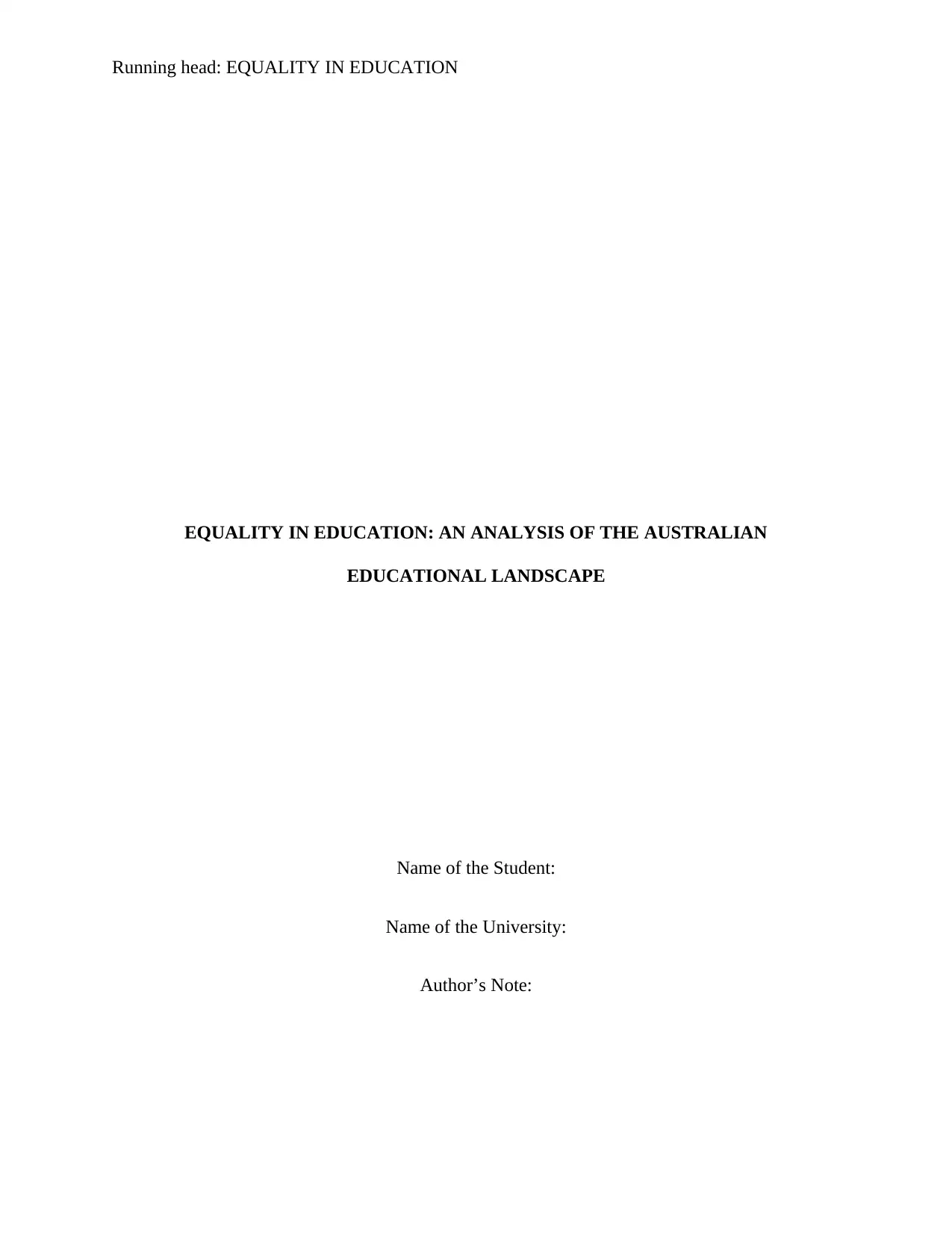
Running head: EQUALITY IN EDUCATION
EQUALITY IN EDUCATION: AN ANALYSIS OF THE AUSTRALIAN
EDUCATIONAL LANDSCAPE
Name of the Student:
Name of the University:
Author’s Note:
EQUALITY IN EDUCATION: AN ANALYSIS OF THE AUSTRALIAN
EDUCATIONAL LANDSCAPE
Name of the Student:
Name of the University:
Author’s Note:
Paraphrase This Document
Need a fresh take? Get an instant paraphrase of this document with our AI Paraphraser

1EQUALITY IN EDUCATION
Introduction
As stated by Schwab (2018), the construct of education helps the individuals to acquire
the skill sets or the knowledge which enables them to perform different job roles adequately in
the latter part of their professional life. Rowe and Perry (2019) are of the viewpoint that
education is an important determinant of the quality that the individuals lead and also determines
their position or status within the societal framework as well. It is because of these aspects that
the national government of the different nations of the world and also the international bodies
like the United Nations and others had made basic education an important right for the
individuals (Myers, 2016). However, it had been seen that within the educational landscape of
the nations like Australia, New Zealand, Canada and others wherein a large number of
indigenous people, immigrants and others reside equality is a major problem or issue which
narrows down the number of individuals to whom education is being offered (Lester, Lochmiller
& Gabriel, 2017).
This issue as a matter of fact had reduced the access to education to the people of the
nation of Australia which in turn had not only adversely affected the quality of life led by the
people of the concerned nation but also slowed down the economic growth of Australia as well.
More importantly, it had been seen that the national government of Australia over the years had
taken the help of the concept of equality and thereby formulated different legislations, policies
and others to ensure that basic as well as advanced education is available to all the individuals of
the concerned nation yet it had failed to attain the desired results through the same (Lubienski &
Yoon, 2017). In this relation, it needs to be said that the most important stakeholders who are
affected by this particular issue within the educational landscape of the nation of Australia are
Introduction
As stated by Schwab (2018), the construct of education helps the individuals to acquire
the skill sets or the knowledge which enables them to perform different job roles adequately in
the latter part of their professional life. Rowe and Perry (2019) are of the viewpoint that
education is an important determinant of the quality that the individuals lead and also determines
their position or status within the societal framework as well. It is because of these aspects that
the national government of the different nations of the world and also the international bodies
like the United Nations and others had made basic education an important right for the
individuals (Myers, 2016). However, it had been seen that within the educational landscape of
the nations like Australia, New Zealand, Canada and others wherein a large number of
indigenous people, immigrants and others reside equality is a major problem or issue which
narrows down the number of individuals to whom education is being offered (Lester, Lochmiller
& Gabriel, 2017).
This issue as a matter of fact had reduced the access to education to the people of the
nation of Australia which in turn had not only adversely affected the quality of life led by the
people of the concerned nation but also slowed down the economic growth of Australia as well.
More importantly, it had been seen that the national government of Australia over the years had
taken the help of the concept of equality and thereby formulated different legislations, policies
and others to ensure that basic as well as advanced education is available to all the individuals of
the concerned nation yet it had failed to attain the desired results through the same (Lubienski &
Yoon, 2017). In this relation, it needs to be said that the most important stakeholders who are
affected by this particular issue within the educational landscape of the nation of Australia are
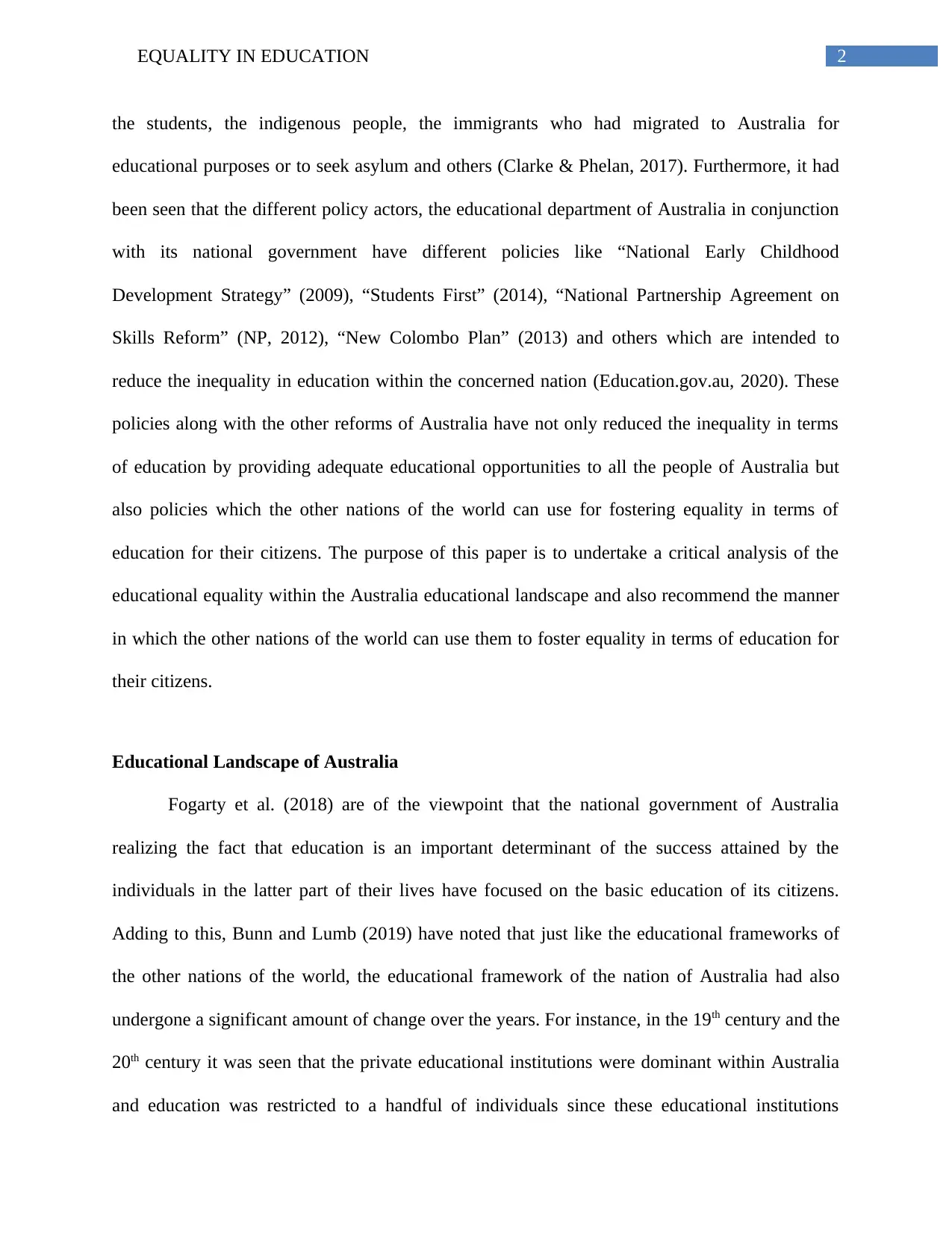
2EQUALITY IN EDUCATION
the students, the indigenous people, the immigrants who had migrated to Australia for
educational purposes or to seek asylum and others (Clarke & Phelan, 2017). Furthermore, it had
been seen that the different policy actors, the educational department of Australia in conjunction
with its national government have different policies like “National Early Childhood
Development Strategy” (2009), “Students First” (2014), “National Partnership Agreement on
Skills Reform” (NP, 2012), “New Colombo Plan” (2013) and others which are intended to
reduce the inequality in education within the concerned nation (Education.gov.au, 2020). These
policies along with the other reforms of Australia have not only reduced the inequality in terms
of education by providing adequate educational opportunities to all the people of Australia but
also policies which the other nations of the world can use for fostering equality in terms of
education for their citizens. The purpose of this paper is to undertake a critical analysis of the
educational equality within the Australia educational landscape and also recommend the manner
in which the other nations of the world can use them to foster equality in terms of education for
their citizens.
Educational Landscape of Australia
Fogarty et al. (2018) are of the viewpoint that the national government of Australia
realizing the fact that education is an important determinant of the success attained by the
individuals in the latter part of their lives have focused on the basic education of its citizens.
Adding to this, Bunn and Lumb (2019) have noted that just like the educational frameworks of
the other nations of the world, the educational framework of the nation of Australia had also
undergone a significant amount of change over the years. For instance, in the 19th century and the
20th century it was seen that the private educational institutions were dominant within Australia
and education was restricted to a handful of individuals since these educational institutions
the students, the indigenous people, the immigrants who had migrated to Australia for
educational purposes or to seek asylum and others (Clarke & Phelan, 2017). Furthermore, it had
been seen that the different policy actors, the educational department of Australia in conjunction
with its national government have different policies like “National Early Childhood
Development Strategy” (2009), “Students First” (2014), “National Partnership Agreement on
Skills Reform” (NP, 2012), “New Colombo Plan” (2013) and others which are intended to
reduce the inequality in education within the concerned nation (Education.gov.au, 2020). These
policies along with the other reforms of Australia have not only reduced the inequality in terms
of education by providing adequate educational opportunities to all the people of Australia but
also policies which the other nations of the world can use for fostering equality in terms of
education for their citizens. The purpose of this paper is to undertake a critical analysis of the
educational equality within the Australia educational landscape and also recommend the manner
in which the other nations of the world can use them to foster equality in terms of education for
their citizens.
Educational Landscape of Australia
Fogarty et al. (2018) are of the viewpoint that the national government of Australia
realizing the fact that education is an important determinant of the success attained by the
individuals in the latter part of their lives have focused on the basic education of its citizens.
Adding to this, Bunn and Lumb (2019) have noted that just like the educational frameworks of
the other nations of the world, the educational framework of the nation of Australia had also
undergone a significant amount of change over the years. For instance, in the 19th century and the
20th century it was seen that the private educational institutions were dominant within Australia
and education was restricted to a handful of individuals since these educational institutions
⊘ This is a preview!⊘
Do you want full access?
Subscribe today to unlock all pages.

Trusted by 1+ million students worldwide
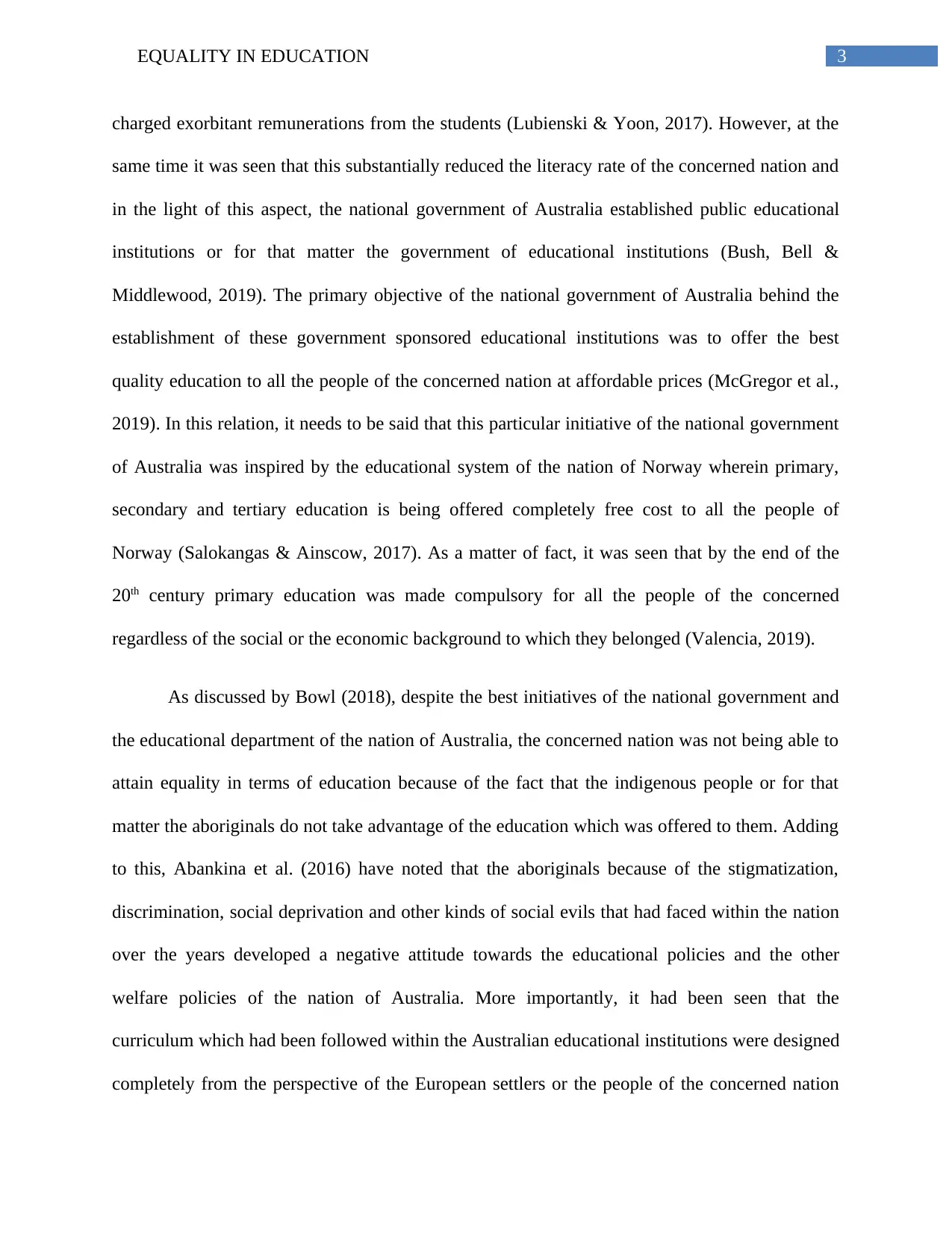
3EQUALITY IN EDUCATION
charged exorbitant remunerations from the students (Lubienski & Yoon, 2017). However, at the
same time it was seen that this substantially reduced the literacy rate of the concerned nation and
in the light of this aspect, the national government of Australia established public educational
institutions or for that matter the government of educational institutions (Bush, Bell &
Middlewood, 2019). The primary objective of the national government of Australia behind the
establishment of these government sponsored educational institutions was to offer the best
quality education to all the people of the concerned nation at affordable prices (McGregor et al.,
2019). In this relation, it needs to be said that this particular initiative of the national government
of Australia was inspired by the educational system of the nation of Norway wherein primary,
secondary and tertiary education is being offered completely free cost to all the people of
Norway (Salokangas & Ainscow, 2017). As a matter of fact, it was seen that by the end of the
20th century primary education was made compulsory for all the people of the concerned
regardless of the social or the economic background to which they belonged (Valencia, 2019).
As discussed by Bowl (2018), despite the best initiatives of the national government and
the educational department of the nation of Australia, the concerned nation was not being able to
attain equality in terms of education because of the fact that the indigenous people or for that
matter the aboriginals do not take advantage of the education which was offered to them. Adding
to this, Abankina et al. (2016) have noted that the aboriginals because of the stigmatization,
discrimination, social deprivation and other kinds of social evils that had faced within the nation
over the years developed a negative attitude towards the educational policies and the other
welfare policies of the nation of Australia. More importantly, it had been seen that the
curriculum which had been followed within the Australian educational institutions were designed
completely from the perspective of the European settlers or the people of the concerned nation
charged exorbitant remunerations from the students (Lubienski & Yoon, 2017). However, at the
same time it was seen that this substantially reduced the literacy rate of the concerned nation and
in the light of this aspect, the national government of Australia established public educational
institutions or for that matter the government of educational institutions (Bush, Bell &
Middlewood, 2019). The primary objective of the national government of Australia behind the
establishment of these government sponsored educational institutions was to offer the best
quality education to all the people of the concerned nation at affordable prices (McGregor et al.,
2019). In this relation, it needs to be said that this particular initiative of the national government
of Australia was inspired by the educational system of the nation of Norway wherein primary,
secondary and tertiary education is being offered completely free cost to all the people of
Norway (Salokangas & Ainscow, 2017). As a matter of fact, it was seen that by the end of the
20th century primary education was made compulsory for all the people of the concerned
regardless of the social or the economic background to which they belonged (Valencia, 2019).
As discussed by Bowl (2018), despite the best initiatives of the national government and
the educational department of the nation of Australia, the concerned nation was not being able to
attain equality in terms of education because of the fact that the indigenous people or for that
matter the aboriginals do not take advantage of the education which was offered to them. Adding
to this, Abankina et al. (2016) have noted that the aboriginals because of the stigmatization,
discrimination, social deprivation and other kinds of social evils that had faced within the nation
over the years developed a negative attitude towards the educational policies and the other
welfare policies of the nation of Australia. More importantly, it had been seen that the
curriculum which had been followed within the Australian educational institutions were designed
completely from the perspective of the European settlers or the people of the concerned nation
Paraphrase This Document
Need a fresh take? Get an instant paraphrase of this document with our AI Paraphraser
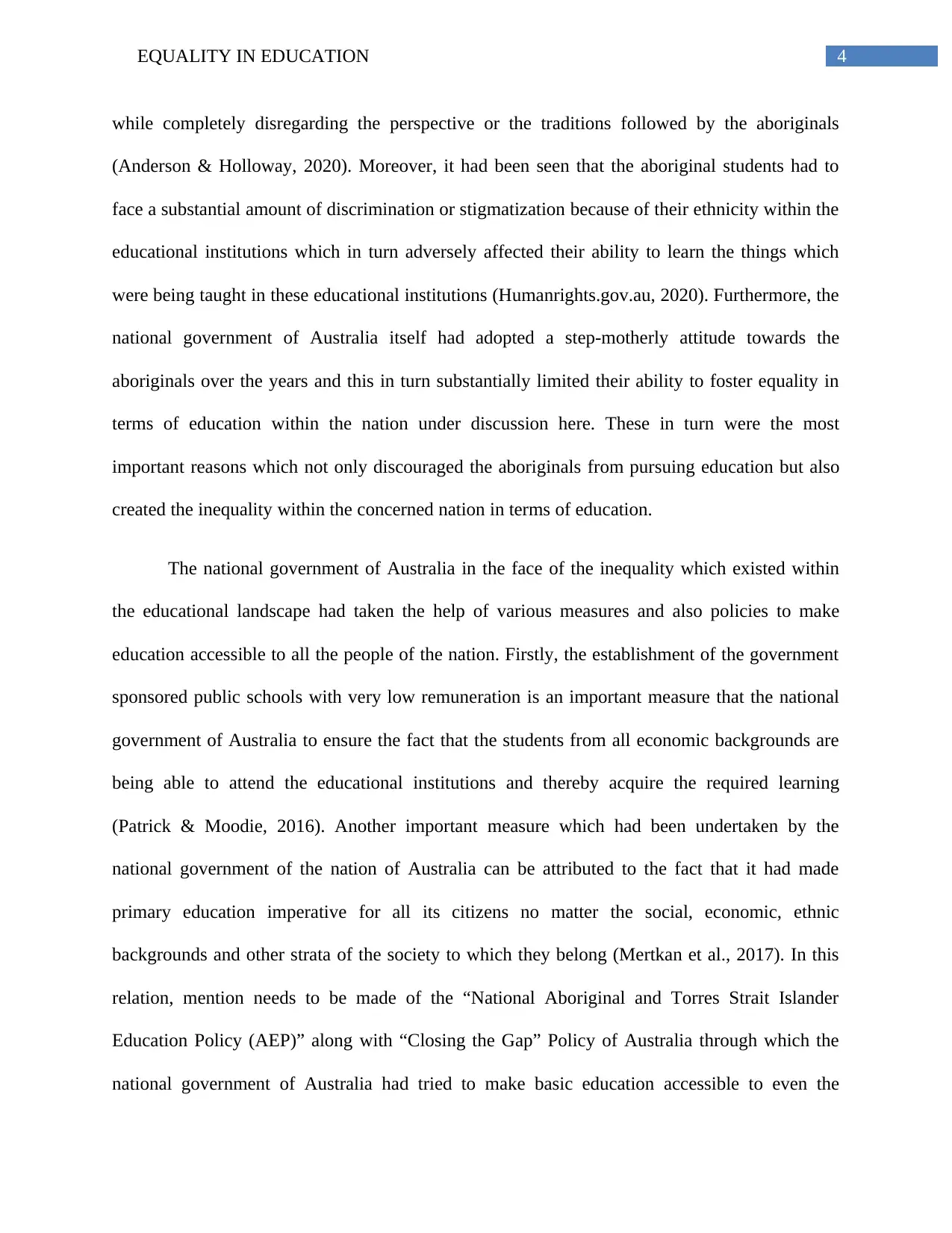
4EQUALITY IN EDUCATION
while completely disregarding the perspective or the traditions followed by the aboriginals
(Anderson & Holloway, 2020). Moreover, it had been seen that the aboriginal students had to
face a substantial amount of discrimination or stigmatization because of their ethnicity within the
educational institutions which in turn adversely affected their ability to learn the things which
were being taught in these educational institutions (Humanrights.gov.au, 2020). Furthermore, the
national government of Australia itself had adopted a step-motherly attitude towards the
aboriginals over the years and this in turn substantially limited their ability to foster equality in
terms of education within the nation under discussion here. These in turn were the most
important reasons which not only discouraged the aboriginals from pursuing education but also
created the inequality within the concerned nation in terms of education.
The national government of Australia in the face of the inequality which existed within
the educational landscape had taken the help of various measures and also policies to make
education accessible to all the people of the nation. Firstly, the establishment of the government
sponsored public schools with very low remuneration is an important measure that the national
government of Australia to ensure the fact that the students from all economic backgrounds are
being able to attend the educational institutions and thereby acquire the required learning
(Patrick & Moodie, 2016). Another important measure which had been undertaken by the
national government of the nation of Australia can be attributed to the fact that it had made
primary education imperative for all its citizens no matter the social, economic, ethnic
backgrounds and other strata of the society to which they belong (Mertkan et al., 2017). In this
relation, mention needs to be made of the “National Aboriginal and Torres Strait Islander
Education Policy (AEP)” along with “Closing the Gap” Policy of Australia through which the
national government of Australia had tried to make basic education accessible to even the
while completely disregarding the perspective or the traditions followed by the aboriginals
(Anderson & Holloway, 2020). Moreover, it had been seen that the aboriginal students had to
face a substantial amount of discrimination or stigmatization because of their ethnicity within the
educational institutions which in turn adversely affected their ability to learn the things which
were being taught in these educational institutions (Humanrights.gov.au, 2020). Furthermore, the
national government of Australia itself had adopted a step-motherly attitude towards the
aboriginals over the years and this in turn substantially limited their ability to foster equality in
terms of education within the nation under discussion here. These in turn were the most
important reasons which not only discouraged the aboriginals from pursuing education but also
created the inequality within the concerned nation in terms of education.
The national government of Australia in the face of the inequality which existed within
the educational landscape had taken the help of various measures and also policies to make
education accessible to all the people of the nation. Firstly, the establishment of the government
sponsored public schools with very low remuneration is an important measure that the national
government of Australia to ensure the fact that the students from all economic backgrounds are
being able to attend the educational institutions and thereby acquire the required learning
(Patrick & Moodie, 2016). Another important measure which had been undertaken by the
national government of the nation of Australia can be attributed to the fact that it had made
primary education imperative for all its citizens no matter the social, economic, ethnic
backgrounds and other strata of the society to which they belong (Mertkan et al., 2017). In this
relation, mention needs to be made of the “National Aboriginal and Torres Strait Islander
Education Policy (AEP)” along with “Closing the Gap” Policy of Australia through which the
national government of Australia had tried to make basic education accessible to even the
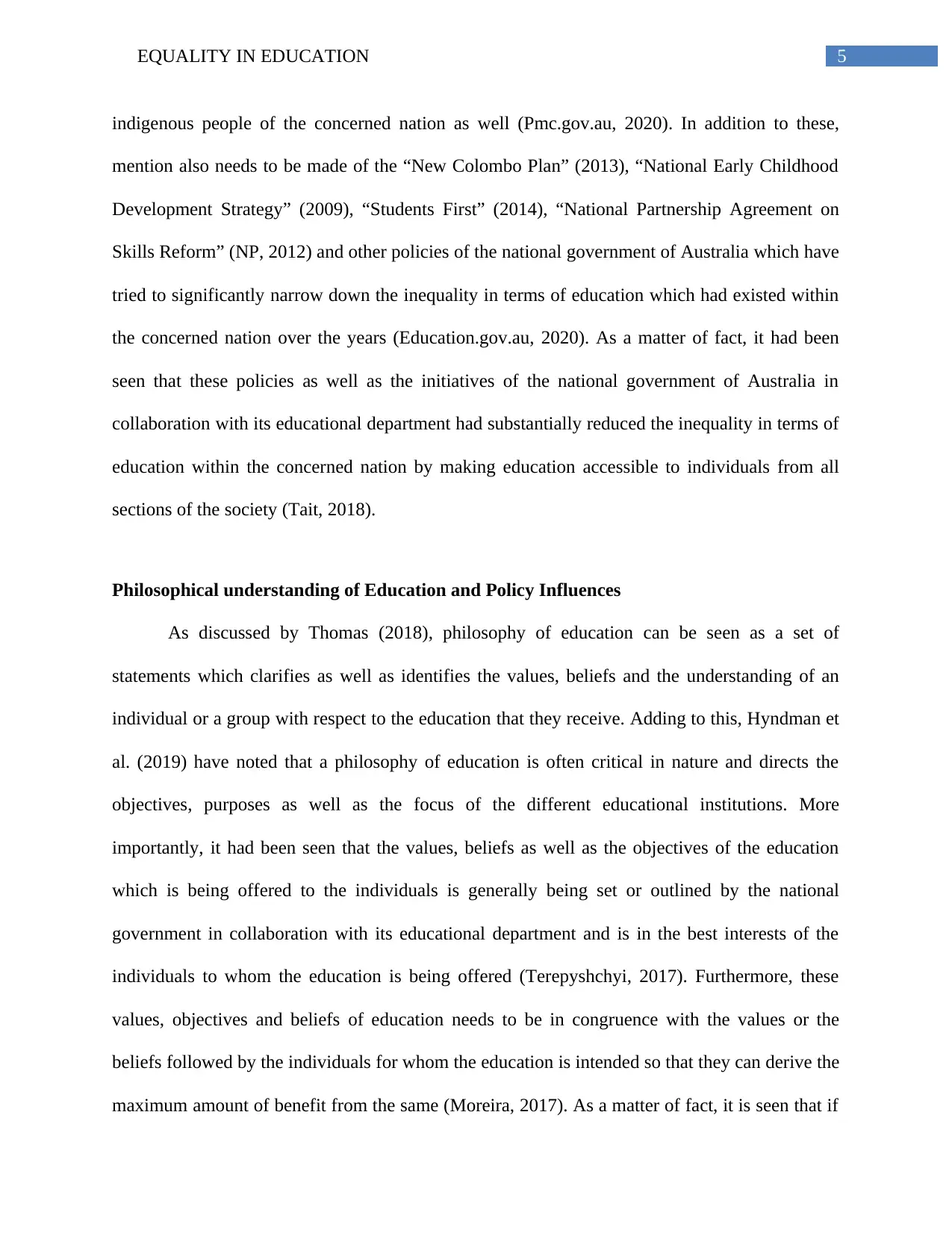
5EQUALITY IN EDUCATION
indigenous people of the concerned nation as well (Pmc.gov.au, 2020). In addition to these,
mention also needs to be made of the “New Colombo Plan” (2013), “National Early Childhood
Development Strategy” (2009), “Students First” (2014), “National Partnership Agreement on
Skills Reform” (NP, 2012) and other policies of the national government of Australia which have
tried to significantly narrow down the inequality in terms of education which had existed within
the concerned nation over the years (Education.gov.au, 2020). As a matter of fact, it had been
seen that these policies as well as the initiatives of the national government of Australia in
collaboration with its educational department had substantially reduced the inequality in terms of
education within the concerned nation by making education accessible to individuals from all
sections of the society (Tait, 2018).
Philosophical understanding of Education and Policy Influences
As discussed by Thomas (2018), philosophy of education can be seen as a set of
statements which clarifies as well as identifies the values, beliefs and the understanding of an
individual or a group with respect to the education that they receive. Adding to this, Hyndman et
al. (2019) have noted that a philosophy of education is often critical in nature and directs the
objectives, purposes as well as the focus of the different educational institutions. More
importantly, it had been seen that the values, beliefs as well as the objectives of the education
which is being offered to the individuals is generally being set or outlined by the national
government in collaboration with its educational department and is in the best interests of the
individuals to whom the education is being offered (Terepyshchyi, 2017). Furthermore, these
values, objectives and beliefs of education needs to be in congruence with the values or the
beliefs followed by the individuals for whom the education is intended so that they can derive the
maximum amount of benefit from the same (Moreira, 2017). As a matter of fact, it is seen that if
indigenous people of the concerned nation as well (Pmc.gov.au, 2020). In addition to these,
mention also needs to be made of the “New Colombo Plan” (2013), “National Early Childhood
Development Strategy” (2009), “Students First” (2014), “National Partnership Agreement on
Skills Reform” (NP, 2012) and other policies of the national government of Australia which have
tried to significantly narrow down the inequality in terms of education which had existed within
the concerned nation over the years (Education.gov.au, 2020). As a matter of fact, it had been
seen that these policies as well as the initiatives of the national government of Australia in
collaboration with its educational department had substantially reduced the inequality in terms of
education within the concerned nation by making education accessible to individuals from all
sections of the society (Tait, 2018).
Philosophical understanding of Education and Policy Influences
As discussed by Thomas (2018), philosophy of education can be seen as a set of
statements which clarifies as well as identifies the values, beliefs and the understanding of an
individual or a group with respect to the education that they receive. Adding to this, Hyndman et
al. (2019) have noted that a philosophy of education is often critical in nature and directs the
objectives, purposes as well as the focus of the different educational institutions. More
importantly, it had been seen that the values, beliefs as well as the objectives of the education
which is being offered to the individuals is generally being set or outlined by the national
government in collaboration with its educational department and is in the best interests of the
individuals to whom the education is being offered (Terepyshchyi, 2017). Furthermore, these
values, objectives and beliefs of education needs to be in congruence with the values or the
beliefs followed by the individuals for whom the education is intended so that they can derive the
maximum amount of benefit from the same (Moreira, 2017). As a matter of fact, it is seen that if
⊘ This is a preview!⊘
Do you want full access?
Subscribe today to unlock all pages.

Trusted by 1+ million students worldwide

6EQUALITY IN EDUCATION
the values, beliefs and the objectives of education are not in compliance with the same followed
by the individuals then they are most likely to not effectively utilize the same and vice versa.
Cumming-Potvin and Martino (2018) are of the viewpoint that an important
philosophical concept that the different educational institutions and also the national government
need to focus upon for offering the required education is equality. Adding to this, Fogarty et al.
(2018) have noted that equality in terms of education becomes important since this will allow
people from all the strata of the society to take advantage of the educational opportunities which
are being offered to them unlike the traditional times wherein it was seen that educational
opportunities were available to only a few individuals of the society. As a matter of fact, within
the nation of Australia it had been seen that educational opportunities were available to only the
European settlers and the aboriginals or the indigenous people of the concerned nation were
completely deprived of the same (Lester, Lochmiller & Gabriel, 2017). This in turn gave rise to
the situation wherein the majority of the indigenous people of the nation under discussion here
were illiterate and this in turn adversely affected both the social and the economic growth of the
concerned nation. This in turn made it imperative for the national government of Australia and
also its educational department to integrate the philosophical concept of equality within the
educational system followed by it so as to make education accessible to people from all strata of
the society of Australia.
According to Rowe and Perry (2019), the embracing of the philosophical concept of
equality within the educational system of the nation of Australia by its national government and
its educational department is the resultant effect of the influences from the different policies
which are being followed by the other nations of the world. In this regard, mention needs to be
made of the educational system of the nation of Norway wherein it had been seen that the
the values, beliefs and the objectives of education are not in compliance with the same followed
by the individuals then they are most likely to not effectively utilize the same and vice versa.
Cumming-Potvin and Martino (2018) are of the viewpoint that an important
philosophical concept that the different educational institutions and also the national government
need to focus upon for offering the required education is equality. Adding to this, Fogarty et al.
(2018) have noted that equality in terms of education becomes important since this will allow
people from all the strata of the society to take advantage of the educational opportunities which
are being offered to them unlike the traditional times wherein it was seen that educational
opportunities were available to only a few individuals of the society. As a matter of fact, within
the nation of Australia it had been seen that educational opportunities were available to only the
European settlers and the aboriginals or the indigenous people of the concerned nation were
completely deprived of the same (Lester, Lochmiller & Gabriel, 2017). This in turn gave rise to
the situation wherein the majority of the indigenous people of the nation under discussion here
were illiterate and this in turn adversely affected both the social and the economic growth of the
concerned nation. This in turn made it imperative for the national government of Australia and
also its educational department to integrate the philosophical concept of equality within the
educational system followed by it so as to make education accessible to people from all strata of
the society of Australia.
According to Rowe and Perry (2019), the embracing of the philosophical concept of
equality within the educational system of the nation of Australia by its national government and
its educational department is the resultant effect of the influences from the different policies
which are being followed by the other nations of the world. In this regard, mention needs to be
made of the educational system of the nation of Norway wherein it had been seen that the
Paraphrase This Document
Need a fresh take? Get an instant paraphrase of this document with our AI Paraphraser
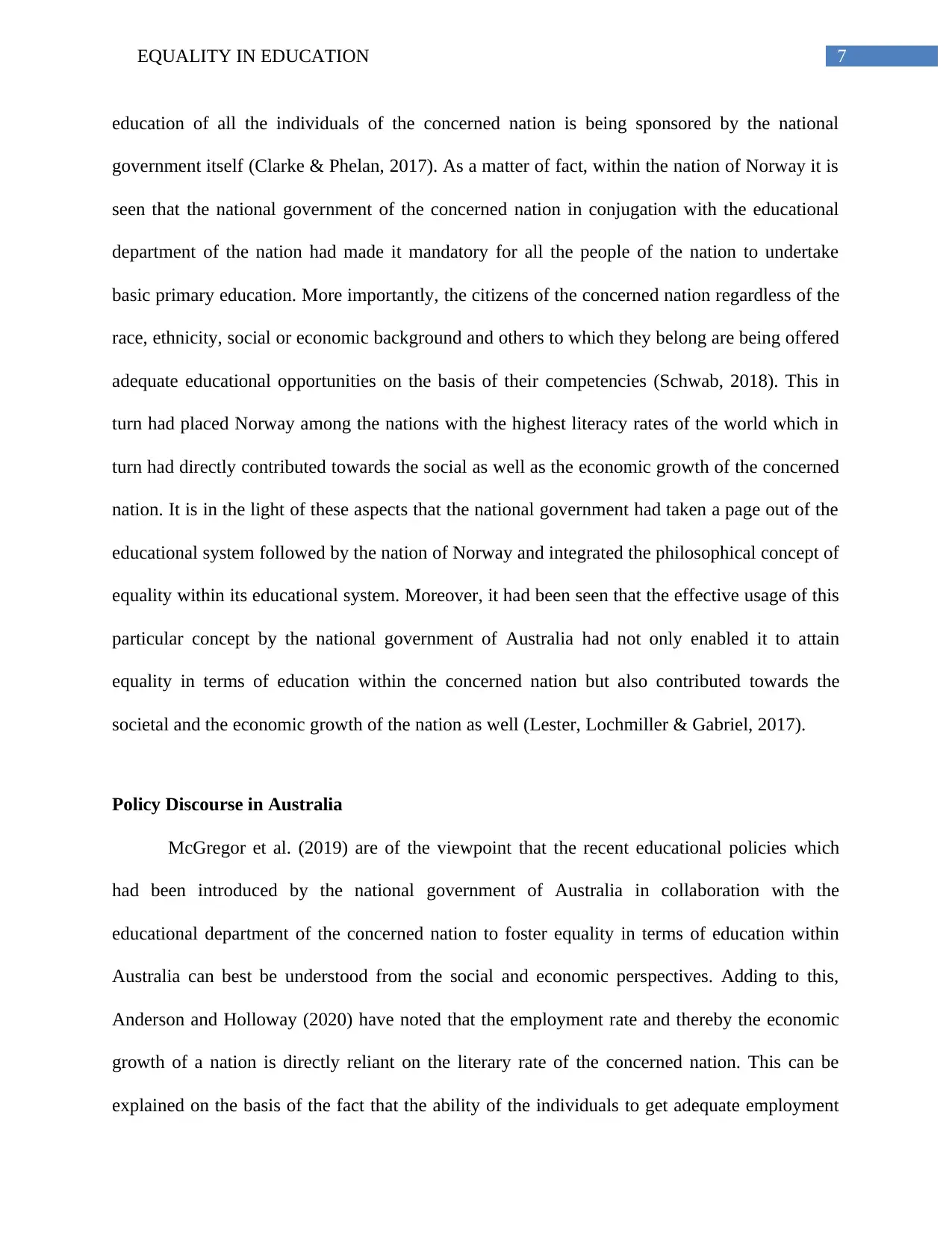
7EQUALITY IN EDUCATION
education of all the individuals of the concerned nation is being sponsored by the national
government itself (Clarke & Phelan, 2017). As a matter of fact, within the nation of Norway it is
seen that the national government of the concerned nation in conjugation with the educational
department of the nation had made it mandatory for all the people of the nation to undertake
basic primary education. More importantly, the citizens of the concerned nation regardless of the
race, ethnicity, social or economic background and others to which they belong are being offered
adequate educational opportunities on the basis of their competencies (Schwab, 2018). This in
turn had placed Norway among the nations with the highest literacy rates of the world which in
turn had directly contributed towards the social as well as the economic growth of the concerned
nation. It is in the light of these aspects that the national government had taken a page out of the
educational system followed by the nation of Norway and integrated the philosophical concept of
equality within its educational system. Moreover, it had been seen that the effective usage of this
particular concept by the national government of Australia had not only enabled it to attain
equality in terms of education within the concerned nation but also contributed towards the
societal and the economic growth of the nation as well (Lester, Lochmiller & Gabriel, 2017).
Policy Discourse in Australia
McGregor et al. (2019) are of the viewpoint that the recent educational policies which
had been introduced by the national government of Australia in collaboration with the
educational department of the concerned nation to foster equality in terms of education within
Australia can best be understood from the social and economic perspectives. Adding to this,
Anderson and Holloway (2020) have noted that the employment rate and thereby the economic
growth of a nation is directly reliant on the literary rate of the concerned nation. This can be
explained on the basis of the fact that the ability of the individuals to get adequate employment
education of all the individuals of the concerned nation is being sponsored by the national
government itself (Clarke & Phelan, 2017). As a matter of fact, within the nation of Norway it is
seen that the national government of the concerned nation in conjugation with the educational
department of the nation had made it mandatory for all the people of the nation to undertake
basic primary education. More importantly, the citizens of the concerned nation regardless of the
race, ethnicity, social or economic background and others to which they belong are being offered
adequate educational opportunities on the basis of their competencies (Schwab, 2018). This in
turn had placed Norway among the nations with the highest literacy rates of the world which in
turn had directly contributed towards the social as well as the economic growth of the concerned
nation. It is in the light of these aspects that the national government had taken a page out of the
educational system followed by the nation of Norway and integrated the philosophical concept of
equality within its educational system. Moreover, it had been seen that the effective usage of this
particular concept by the national government of Australia had not only enabled it to attain
equality in terms of education within the concerned nation but also contributed towards the
societal and the economic growth of the nation as well (Lester, Lochmiller & Gabriel, 2017).
Policy Discourse in Australia
McGregor et al. (2019) are of the viewpoint that the recent educational policies which
had been introduced by the national government of Australia in collaboration with the
educational department of the concerned nation to foster equality in terms of education within
Australia can best be understood from the social and economic perspectives. Adding to this,
Anderson and Holloway (2020) have noted that the employment rate and thereby the economic
growth of a nation is directly reliant on the literary rate of the concerned nation. This can be
explained on the basis of the fact that the ability of the individuals to get adequate employment
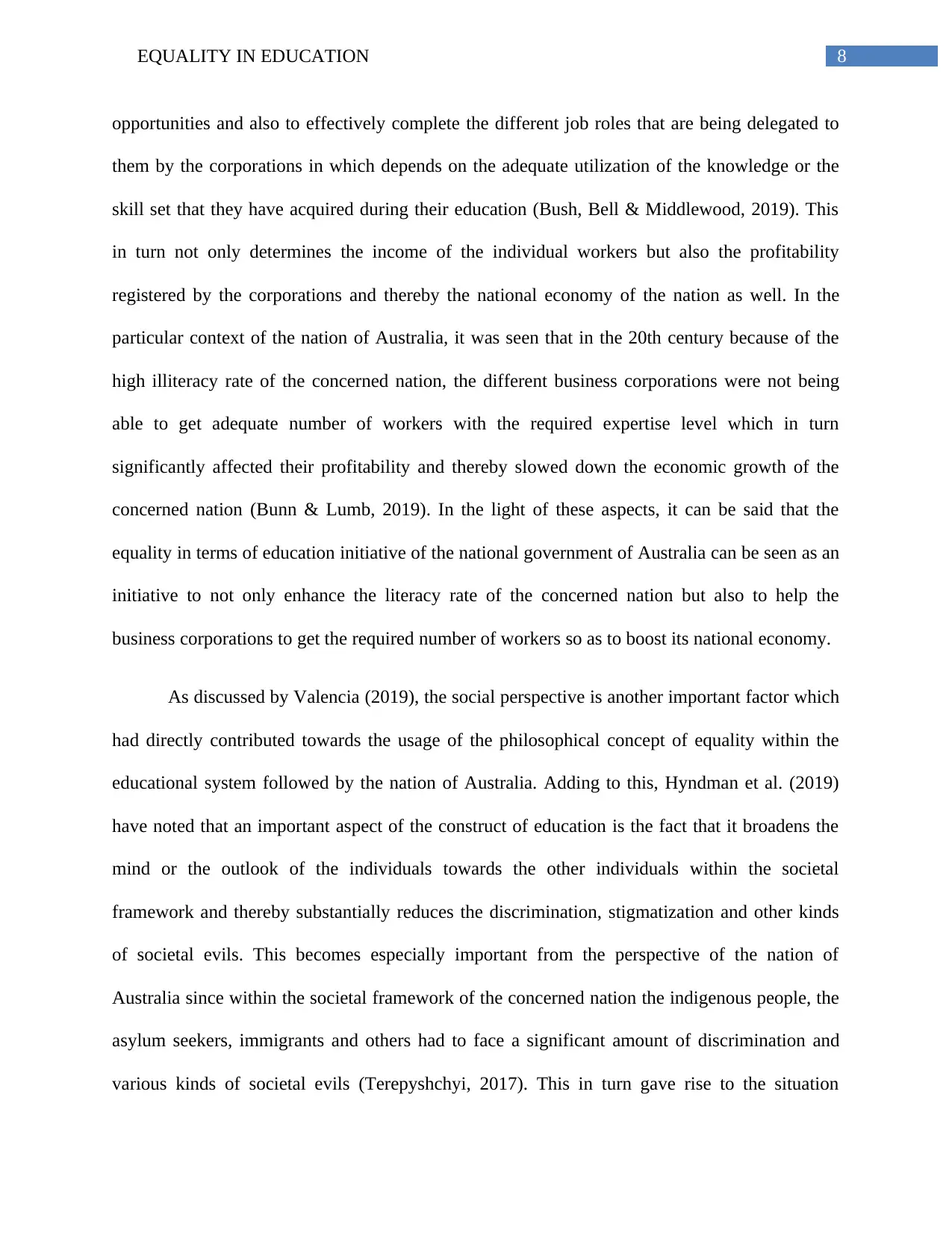
8EQUALITY IN EDUCATION
opportunities and also to effectively complete the different job roles that are being delegated to
them by the corporations in which depends on the adequate utilization of the knowledge or the
skill set that they have acquired during their education (Bush, Bell & Middlewood, 2019). This
in turn not only determines the income of the individual workers but also the profitability
registered by the corporations and thereby the national economy of the nation as well. In the
particular context of the nation of Australia, it was seen that in the 20th century because of the
high illiteracy rate of the concerned nation, the different business corporations were not being
able to get adequate number of workers with the required expertise level which in turn
significantly affected their profitability and thereby slowed down the economic growth of the
concerned nation (Bunn & Lumb, 2019). In the light of these aspects, it can be said that the
equality in terms of education initiative of the national government of Australia can be seen as an
initiative to not only enhance the literacy rate of the concerned nation but also to help the
business corporations to get the required number of workers so as to boost its national economy.
As discussed by Valencia (2019), the social perspective is another important factor which
had directly contributed towards the usage of the philosophical concept of equality within the
educational system followed by the nation of Australia. Adding to this, Hyndman et al. (2019)
have noted that an important aspect of the construct of education is the fact that it broadens the
mind or the outlook of the individuals towards the other individuals within the societal
framework and thereby substantially reduces the discrimination, stigmatization and other kinds
of societal evils. This becomes especially important from the perspective of the nation of
Australia since within the societal framework of the concerned nation the indigenous people, the
asylum seekers, immigrants and others had to face a significant amount of discrimination and
various kinds of societal evils (Terepyshchyi, 2017). This in turn gave rise to the situation
opportunities and also to effectively complete the different job roles that are being delegated to
them by the corporations in which depends on the adequate utilization of the knowledge or the
skill set that they have acquired during their education (Bush, Bell & Middlewood, 2019). This
in turn not only determines the income of the individual workers but also the profitability
registered by the corporations and thereby the national economy of the nation as well. In the
particular context of the nation of Australia, it was seen that in the 20th century because of the
high illiteracy rate of the concerned nation, the different business corporations were not being
able to get adequate number of workers with the required expertise level which in turn
significantly affected their profitability and thereby slowed down the economic growth of the
concerned nation (Bunn & Lumb, 2019). In the light of these aspects, it can be said that the
equality in terms of education initiative of the national government of Australia can be seen as an
initiative to not only enhance the literacy rate of the concerned nation but also to help the
business corporations to get the required number of workers so as to boost its national economy.
As discussed by Valencia (2019), the social perspective is another important factor which
had directly contributed towards the usage of the philosophical concept of equality within the
educational system followed by the nation of Australia. Adding to this, Hyndman et al. (2019)
have noted that an important aspect of the construct of education is the fact that it broadens the
mind or the outlook of the individuals towards the other individuals within the societal
framework and thereby substantially reduces the discrimination, stigmatization and other kinds
of societal evils. This becomes especially important from the perspective of the nation of
Australia since within the societal framework of the concerned nation the indigenous people, the
asylum seekers, immigrants and others had to face a significant amount of discrimination and
various kinds of societal evils (Terepyshchyi, 2017). This in turn gave rise to the situation
⊘ This is a preview!⊘
Do you want full access?
Subscribe today to unlock all pages.

Trusted by 1+ million students worldwide
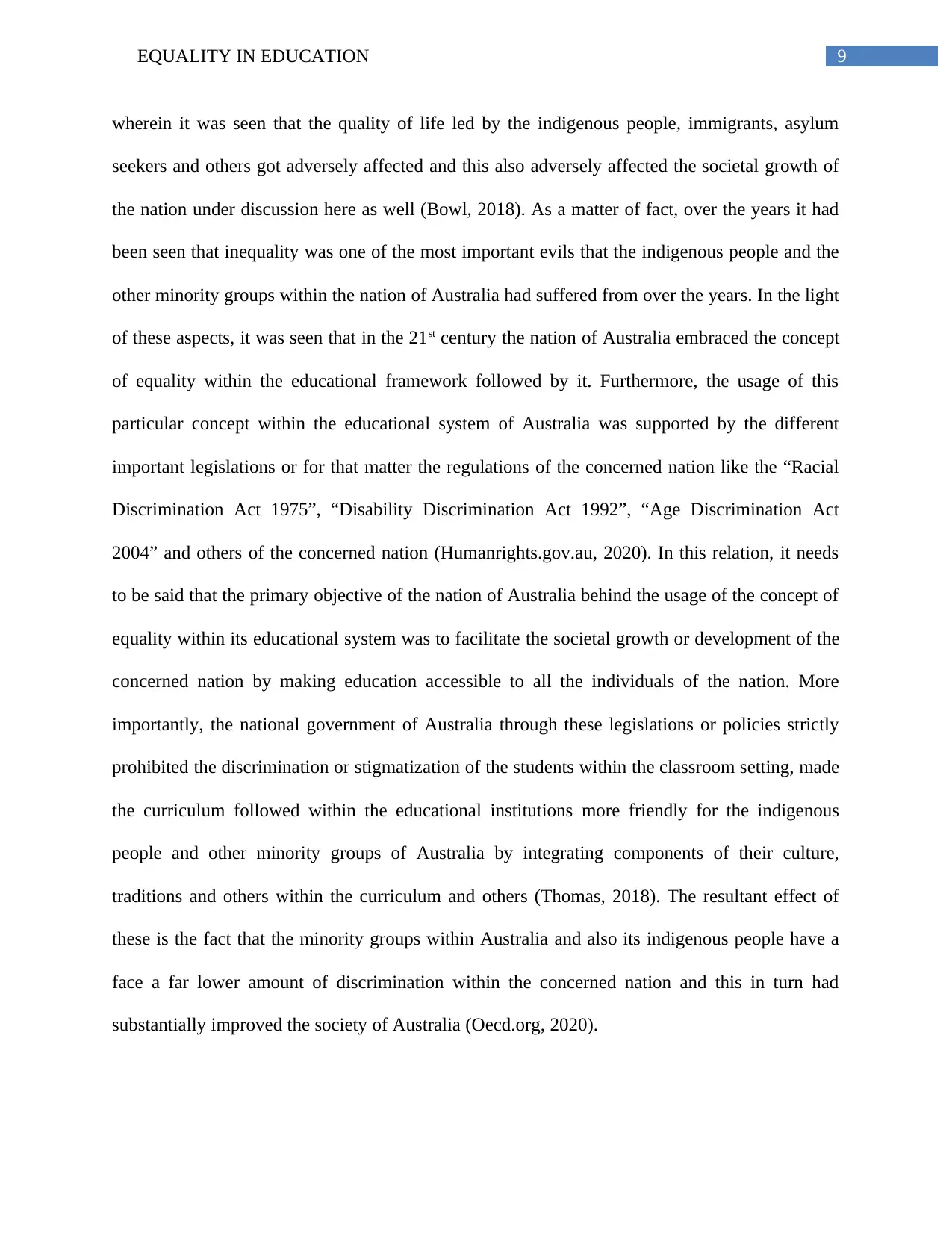
9EQUALITY IN EDUCATION
wherein it was seen that the quality of life led by the indigenous people, immigrants, asylum
seekers and others got adversely affected and this also adversely affected the societal growth of
the nation under discussion here as well (Bowl, 2018). As a matter of fact, over the years it had
been seen that inequality was one of the most important evils that the indigenous people and the
other minority groups within the nation of Australia had suffered from over the years. In the light
of these aspects, it was seen that in the 21st century the nation of Australia embraced the concept
of equality within the educational framework followed by it. Furthermore, the usage of this
particular concept within the educational system of Australia was supported by the different
important legislations or for that matter the regulations of the concerned nation like the “Racial
Discrimination Act 1975”, “Disability Discrimination Act 1992”, “Age Discrimination Act
2004” and others of the concerned nation (Humanrights.gov.au, 2020). In this relation, it needs
to be said that the primary objective of the nation of Australia behind the usage of the concept of
equality within its educational system was to facilitate the societal growth or development of the
concerned nation by making education accessible to all the individuals of the nation. More
importantly, the national government of Australia through these legislations or policies strictly
prohibited the discrimination or stigmatization of the students within the classroom setting, made
the curriculum followed within the educational institutions more friendly for the indigenous
people and other minority groups of Australia by integrating components of their culture,
traditions and others within the curriculum and others (Thomas, 2018). The resultant effect of
these is the fact that the minority groups within Australia and also its indigenous people have a
face a far lower amount of discrimination within the concerned nation and this in turn had
substantially improved the society of Australia (Oecd.org, 2020).
wherein it was seen that the quality of life led by the indigenous people, immigrants, asylum
seekers and others got adversely affected and this also adversely affected the societal growth of
the nation under discussion here as well (Bowl, 2018). As a matter of fact, over the years it had
been seen that inequality was one of the most important evils that the indigenous people and the
other minority groups within the nation of Australia had suffered from over the years. In the light
of these aspects, it was seen that in the 21st century the nation of Australia embraced the concept
of equality within the educational framework followed by it. Furthermore, the usage of this
particular concept within the educational system of Australia was supported by the different
important legislations or for that matter the regulations of the concerned nation like the “Racial
Discrimination Act 1975”, “Disability Discrimination Act 1992”, “Age Discrimination Act
2004” and others of the concerned nation (Humanrights.gov.au, 2020). In this relation, it needs
to be said that the primary objective of the nation of Australia behind the usage of the concept of
equality within its educational system was to facilitate the societal growth or development of the
concerned nation by making education accessible to all the individuals of the nation. More
importantly, the national government of Australia through these legislations or policies strictly
prohibited the discrimination or stigmatization of the students within the classroom setting, made
the curriculum followed within the educational institutions more friendly for the indigenous
people and other minority groups of Australia by integrating components of their culture,
traditions and others within the curriculum and others (Thomas, 2018). The resultant effect of
these is the fact that the minority groups within Australia and also its indigenous people have a
face a far lower amount of discrimination within the concerned nation and this in turn had
substantially improved the society of Australia (Oecd.org, 2020).
Paraphrase This Document
Need a fresh take? Get an instant paraphrase of this document with our AI Paraphraser
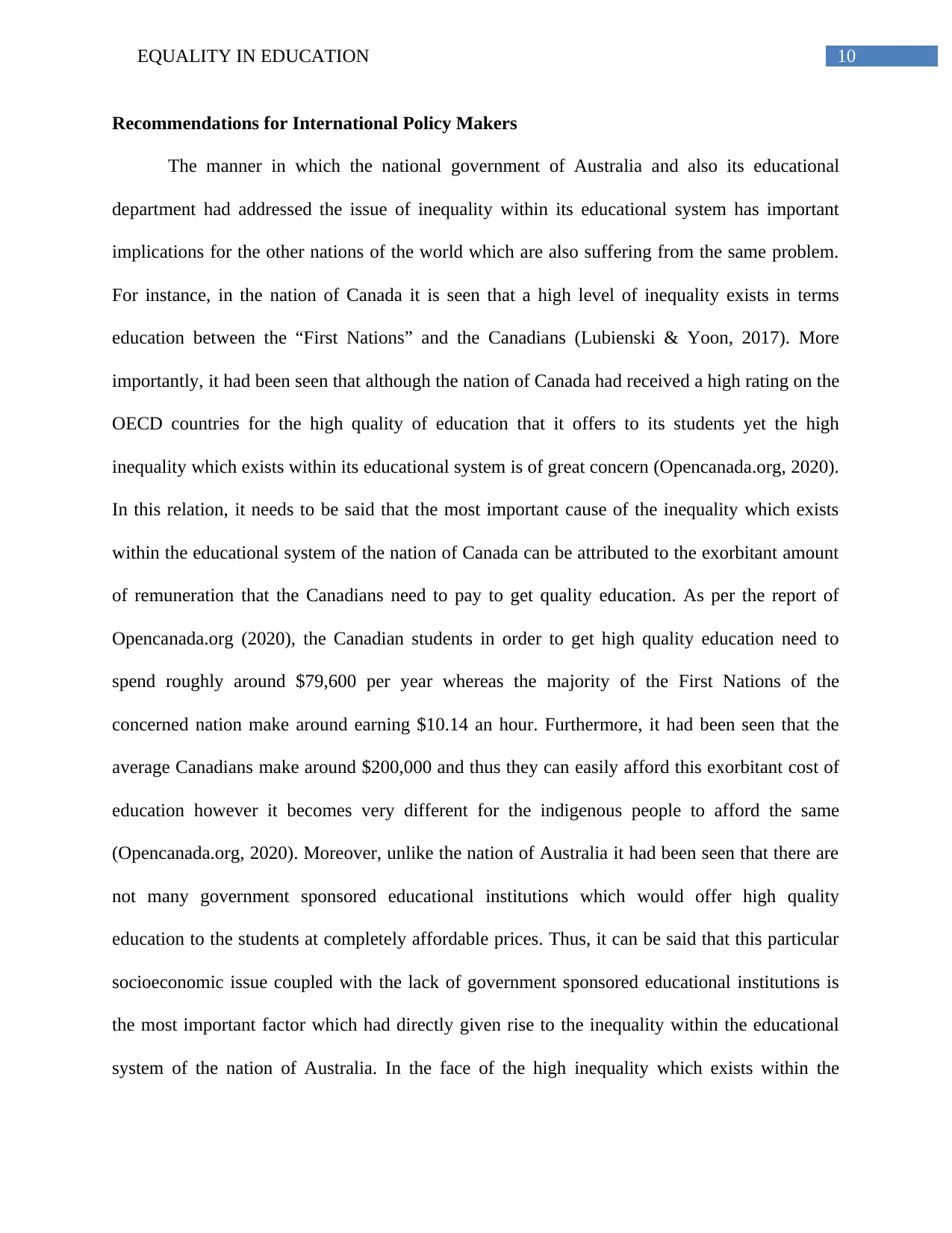
10EQUALITY IN EDUCATION
Recommendations for International Policy Makers
The manner in which the national government of Australia and also its educational
department had addressed the issue of inequality within its educational system has important
implications for the other nations of the world which are also suffering from the same problem.
For instance, in the nation of Canada it is seen that a high level of inequality exists in terms
education between the “First Nations” and the Canadians (Lubienski & Yoon, 2017). More
importantly, it had been seen that although the nation of Canada had received a high rating on the
OECD countries for the high quality of education that it offers to its students yet the high
inequality which exists within its educational system is of great concern (Opencanada.org, 2020).
In this relation, it needs to be said that the most important cause of the inequality which exists
within the educational system of the nation of Canada can be attributed to the exorbitant amount
of remuneration that the Canadians need to pay to get quality education. As per the report of
Opencanada.org (2020), the Canadian students in order to get high quality education need to
spend roughly around $79,600 per year whereas the majority of the First Nations of the
concerned nation make around earning $10.14 an hour. Furthermore, it had been seen that the
average Canadians make around $200,000 and thus they can easily afford this exorbitant cost of
education however it becomes very different for the indigenous people to afford the same
(Opencanada.org, 2020). Moreover, unlike the nation of Australia it had been seen that there are
not many government sponsored educational institutions which would offer high quality
education to the students at completely affordable prices. Thus, it can be said that this particular
socioeconomic issue coupled with the lack of government sponsored educational institutions is
the most important factor which had directly given rise to the inequality within the educational
system of the nation of Australia. In the face of the high inequality which exists within the
Recommendations for International Policy Makers
The manner in which the national government of Australia and also its educational
department had addressed the issue of inequality within its educational system has important
implications for the other nations of the world which are also suffering from the same problem.
For instance, in the nation of Canada it is seen that a high level of inequality exists in terms
education between the “First Nations” and the Canadians (Lubienski & Yoon, 2017). More
importantly, it had been seen that although the nation of Canada had received a high rating on the
OECD countries for the high quality of education that it offers to its students yet the high
inequality which exists within its educational system is of great concern (Opencanada.org, 2020).
In this relation, it needs to be said that the most important cause of the inequality which exists
within the educational system of the nation of Canada can be attributed to the exorbitant amount
of remuneration that the Canadians need to pay to get quality education. As per the report of
Opencanada.org (2020), the Canadian students in order to get high quality education need to
spend roughly around $79,600 per year whereas the majority of the First Nations of the
concerned nation make around earning $10.14 an hour. Furthermore, it had been seen that the
average Canadians make around $200,000 and thus they can easily afford this exorbitant cost of
education however it becomes very different for the indigenous people to afford the same
(Opencanada.org, 2020). Moreover, unlike the nation of Australia it had been seen that there are
not many government sponsored educational institutions which would offer high quality
education to the students at completely affordable prices. Thus, it can be said that this particular
socioeconomic issue coupled with the lack of government sponsored educational institutions is
the most important factor which had directly given rise to the inequality within the educational
system of the nation of Australia. In the face of the high inequality which exists within the
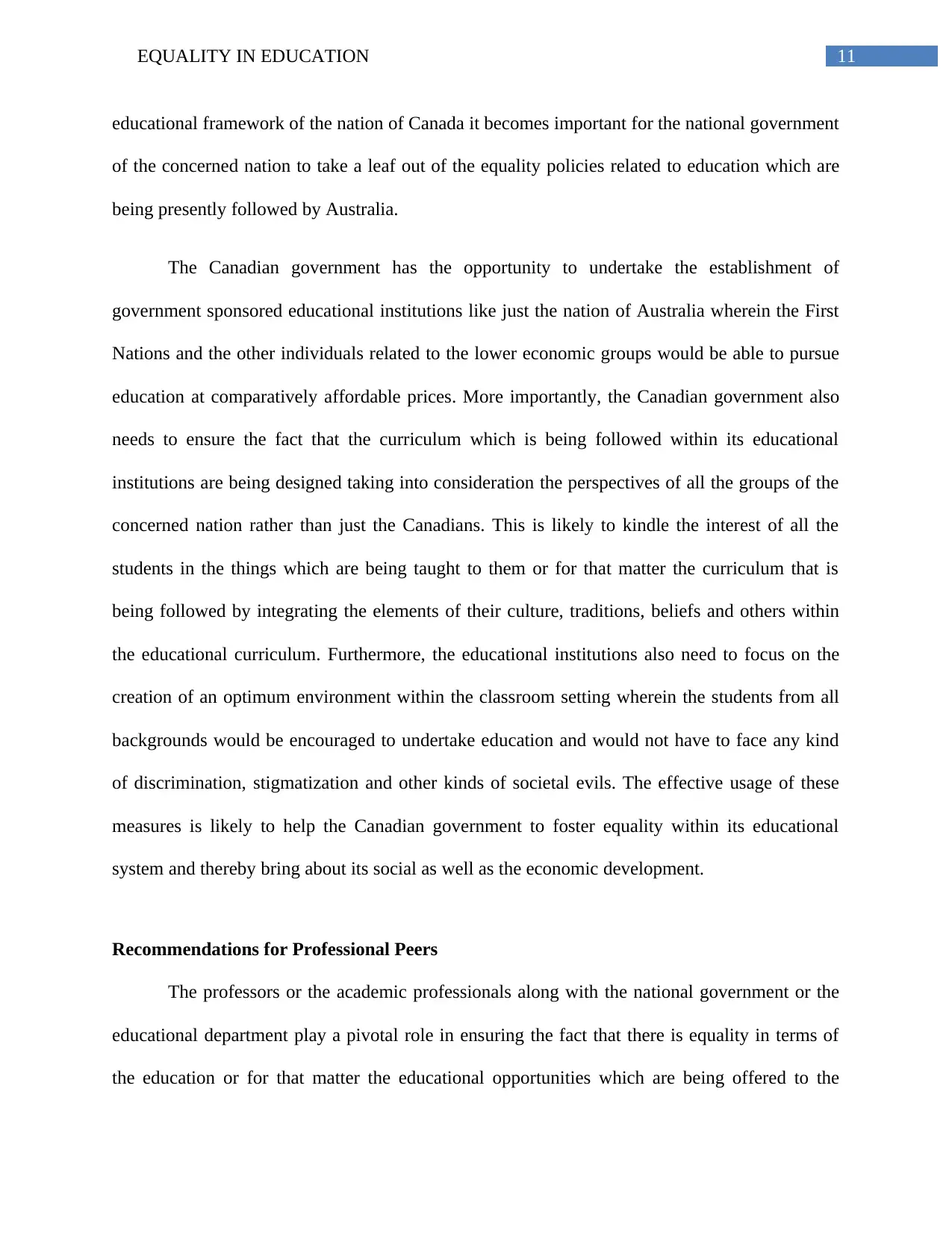
11EQUALITY IN EDUCATION
educational framework of the nation of Canada it becomes important for the national government
of the concerned nation to take a leaf out of the equality policies related to education which are
being presently followed by Australia.
The Canadian government has the opportunity to undertake the establishment of
government sponsored educational institutions like just the nation of Australia wherein the First
Nations and the other individuals related to the lower economic groups would be able to pursue
education at comparatively affordable prices. More importantly, the Canadian government also
needs to ensure the fact that the curriculum which is being followed within its educational
institutions are being designed taking into consideration the perspectives of all the groups of the
concerned nation rather than just the Canadians. This is likely to kindle the interest of all the
students in the things which are being taught to them or for that matter the curriculum that is
being followed by integrating the elements of their culture, traditions, beliefs and others within
the educational curriculum. Furthermore, the educational institutions also need to focus on the
creation of an optimum environment within the classroom setting wherein the students from all
backgrounds would be encouraged to undertake education and would not have to face any kind
of discrimination, stigmatization and other kinds of societal evils. The effective usage of these
measures is likely to help the Canadian government to foster equality within its educational
system and thereby bring about its social as well as the economic development.
Recommendations for Professional Peers
The professors or the academic professionals along with the national government or the
educational department play a pivotal role in ensuring the fact that there is equality in terms of
the education or for that matter the educational opportunities which are being offered to the
educational framework of the nation of Canada it becomes important for the national government
of the concerned nation to take a leaf out of the equality policies related to education which are
being presently followed by Australia.
The Canadian government has the opportunity to undertake the establishment of
government sponsored educational institutions like just the nation of Australia wherein the First
Nations and the other individuals related to the lower economic groups would be able to pursue
education at comparatively affordable prices. More importantly, the Canadian government also
needs to ensure the fact that the curriculum which is being followed within its educational
institutions are being designed taking into consideration the perspectives of all the groups of the
concerned nation rather than just the Canadians. This is likely to kindle the interest of all the
students in the things which are being taught to them or for that matter the curriculum that is
being followed by integrating the elements of their culture, traditions, beliefs and others within
the educational curriculum. Furthermore, the educational institutions also need to focus on the
creation of an optimum environment within the classroom setting wherein the students from all
backgrounds would be encouraged to undertake education and would not have to face any kind
of discrimination, stigmatization and other kinds of societal evils. The effective usage of these
measures is likely to help the Canadian government to foster equality within its educational
system and thereby bring about its social as well as the economic development.
Recommendations for Professional Peers
The professors or the academic professionals along with the national government or the
educational department play a pivotal role in ensuring the fact that there is equality in terms of
the education or for that matter the educational opportunities which are being offered to the
⊘ This is a preview!⊘
Do you want full access?
Subscribe today to unlock all pages.

Trusted by 1+ million students worldwide
1 out of 18
Related Documents
Your All-in-One AI-Powered Toolkit for Academic Success.
+13062052269
info@desklib.com
Available 24*7 on WhatsApp / Email
![[object Object]](/_next/static/media/star-bottom.7253800d.svg)
Unlock your academic potential
Copyright © 2020–2025 A2Z Services. All Rights Reserved. Developed and managed by ZUCOL.





